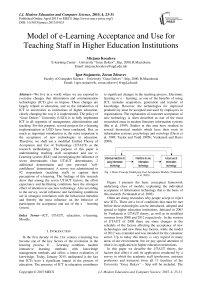Model of e-Learning Acceptance and Use for Teaching Staff in Higher Education Institutions
Автор: Mirjana Kocaleva, Igor Stojanovic, Zoran Zdravev
Журнал: International Journal of Modern Education and Computer Science (IJMECS) @ijmecs
Статья в выпуске: 4 vol.7, 2015 года.
Бесплатный доступ
We live in a world where we are exposed to everyday changes that information and communication technologies (ICT) give us impose. These changes are largely related to education, and so the introduction of ICT in universities as institutions of higher education, clearly changing the way it is implemented. The policy of "Goce Delcev" University (UGD) is to fully implement ICT in all segments of management, administration and teaching. For this purpose, several projects for e-learning implementation at UGD have been conducted. But, as much as important introduction is, the more important is the acceptance of new technologies in education. Therefore, we shall use a modified Unified Theory of Acceptance and Use of Technology (UTAUT) as the research methodology. The purpose of this paper is understanding teaching staff acceptance and use e-Learning system (ELC) and investigating the influence of seven determinants (four UTAUT determinants, 2 additional determinants and one personal "self-confidence" determinant). A survey was administered to 92 respondents (teaching staff) to capture their perceptions of e-learning. The findings of this research show that among the seven UTAUT factors, the effort expectancy and facilitating conditions have the strongest effect of intention to use new technology. Also according to the survey, social influence and facilitating conditions are in strongest correlation with the behavioral intention and thereby the most influence on the behavior of participants for acceptance and use of the e – learning system.
ICT, UTAUT, education, e-learning, Moodle
Короткий адрес: https://sciup.org/15014746
IDR: 15014746
Список литературы Model of e-Learning Acceptance and Use for Teaching Staff in Higher Education Institutions
- Allah Nawaz,Muhammad Zubair Khan (2012). Issues of Technical Support for e-Learning Systems in Higher Education Institutions, IJMECS, vol.4, no.2, pp.38-44.
- Amani J. Algharibi, Theodoros N. Arvanitis. (2011). Adapting the Unified Theory of Acceptance and Use of Technology (UTAUT) as a Tool for Validating User Needs on the Implementation of e-Trial Software Systems. BCS-HCI '11 Proceedings of the 25th BCS Conference on Human-Computer Interaction, 526-530.
- Bens Pardamean, Mario Susanto, Harisno. (2011). Acceptance of Blog Technology in e-Business Course. E-Activities, 185-190.
- Carmen C. Lewis, Cherie E. Fretwell, Jim Ryan, James B. Parham. (2013). Faculty Use of Established and Emerging Technologies in Higher Education: A Unified Theory of Acceptance and Use of Technology Perspective. International Journal of Higher Education, 22-34.
- Chang, C.-C. (2013). Library mobile applications in university libraries. Emerald, 478-492.
- Christer Carlsson, Joanna Carlsson, Kaarina Hyvönen, Jussi Puhakainen, Pirkko Walden. (2006). Adoption of Mobile Devices/Services – Searching for Answers with the UTAUT. Proceedings of the 39th Hawaii International Conference on System Sciences, 1-10.
- E. AbuShanab, J.M. Pearson. (2012). Emerald Article: Internet banking in Jordan: The unified theory of acceptance and use of technology (UTAUT) perspective. Journal of Systems and Information Technology - Emerald, 78 - 97.
- Héctor San Martín, Ángel Herrero. (2012). Influence of the user's psychological factors on the online purchase intention in rural tourism: Integrating innovativeness to the UTAUT framework. Tourism Management, 341-350.
- II Im, Seongtae hong, Myung Soo Kang. (2011). An international comparison of technology adoption Testing the UTAUT model. Information & Management, 48, 1-8.
- J.Moran, M. (2006). College student's acceptance of tablet personal computers: a modification of the UTAUT. Capella University.
- Michail N. Giannakos,Panayiotis Vlamos. (2011). Identifying the Predictors of Educational Webcasts' Adoption. Innovation and Technology in Computer Science Education, 376.
- Mike Wade, Scott Schneberger. (2005, September 30). Retrieved from The Theories Used in IS Research : http://www.istheory.yorku.ca/UTAUT.htm.
- Mohammed Alshehri, Steve Drew, Rayed AlGhamdi. (2012). Analusis of citizens' acceptance for e-government services: Applying the UTAUT model. IADIS International Conferences Theory and Practice in Modern Computing and Internet Applications and Research.
- N.D. Oye, N. A. Iahad, Zairah Ab. Rabin. (2011). A Model of ICT Acceptance and Use for Teachers in Higher Education Institutions. International Journal of Computer Science & Communication Networks, 22-40.
- Mirjana Kocaleva, Igor Stojanovik, Zoran Zdravev. (2014). UTAUT and its application in an educational environment: State-of-the Art. Yearbook 2013 - Faculty of Computer Science, 2 (2). pp. 95-102. ISSN 1857- 8691.
- Mirjana Kocaleva, Igor Stojanovik, Zoran Zdravev. (2014). Research on UTAUT Application in Higher Education Institutions. ITRO 2014, 27 June 2014, Zrenjanin, Serbia. pp. 34-39.
- Viswanath Venkatesh, James Y. L. Thong, Xin Xu. (2012). Consumer acceptance and use of information technology: extending the unified theory of acceptance and use of technology. MIS Quarterly, 157-178.
- Viswanath Venkatesh, Michael G. Morris, Gordon B. Davis, Fred D. Davis. (2003). User acceptance of information technology: Toward a unified view. MIS Quarterly, 425-478.
- Zahraa F. Muhsen,Adi Maaita,Ashraf Odah,Ayman Nsour (2013). Moodle and e-learning Tools, IJMECS, vol.5, no.6, pp.1-8.
- Zoran Zdravev. (2010). Integrating ICT in Teachers Education - Case study at "Goce Delcev" University. BASOPED - 13th International Conference - ICT in the education of the Balkan countries.
- Zoran Zdravev, Gorgi Dimov, Silvana Krsteva . (2011). E-learning in Higher Education through E-learning center. Conference for Informatics and Information Technology, 1-4.
- Zoran Zdravev, Silvana Zezova, Gorgi Dimov. (2012/2013). E-learning implementation ат ugd – lessons learned. Vospitanie br.12, 149-158.


